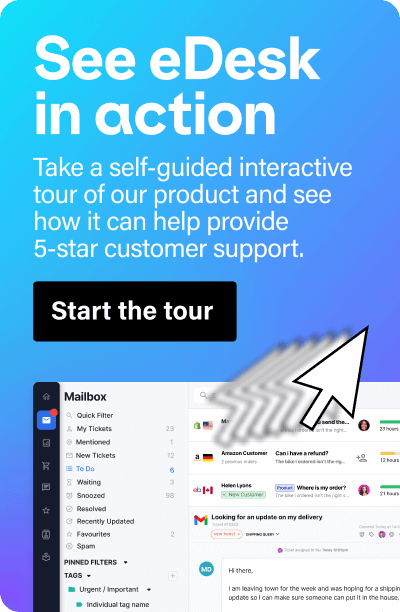Providing excellent customer service can be a juggling act: you have to balance customers’ needs against the possible solutions and know-how to take the best course of action in each situation.
It’s not an easy role, but it is an incredibly important one, especially when you consider that a customer service representative is the ‘face’ of your business, providing each customer with a representation of what it means to interact with your company.
To provide good customer service, agents need the basics in their customer service toolkit:
- Training
- Empathy
- Product/service knowledge
- Patience
But one ‘tool’ that is often overlooked is possibly one of the most important: a customer service mindset. In this article, we’ll discuss why a customer service mindset is one of the most important – and often underrated – skills a customer service professional can possess and why it’s critical to business success that they have it.
What is a Customer Service Mindset?
A customer service mindset is a way of approaching customer service that puts the customer’s needs first and goes a step further to think above and beyond what can be done to improve the customer experience.
This mindset is found in the most successful customer service employees and results in achieving customer satisfaction and customer success in the short term, as well as building customer loyalty in the long term.
Because it focuses on providing top-notch service to every type of customer and doing whatever it takes to solve a problem, a customer service mindset is well-suited to dealing with all kinds of customer requests and issues, even the most difficult ones.
A customer service team with a strong customer service mindset not only finds solutions to customer problems but communicates those solutions clearly and effectively to customers.
An Example of a Customer Service Mindset
Customer service representatives who possess a customer service mindset are focused on creating added value for their customers. But what does this look like in practice?
Here’s an example of an agent demonstrating a customer service mindset:
An agent is contacted by a customer who says they haven’t yet received their order and the time of the shipping window has passed.
The agent can simply track the order and shipping and let the customer know when it will arrive. This would surely solve the customer’s problem? But it doesn’t really go above and beyond the customer’s expectations. This is simply the most basic solution that a customer service representative can possibly provide.
However, a customer service representative with a customer service mindset will understand that it’s not enough to just solve the problem at its most basic level. To truly elevate customer service using a customer service mindset, the agent will want to go above and beyond.
In this example, an agent can demonstrate a customer service mindset by tracking the order and shipment and providing the customer with detailed tracking information straight to their inbox. They can also let the customer know that they are getting in touch with the courier to prioritise the shipment and end the interaction by providing the customer with a voucher code for 10% off their next order.
In this way, the agent is going beyond the problem at hand to add value for the customer and offering recompense (the voucher) in anticipation of the customer’s disappointment with the delayed shipping. This is one example of what a customer service mindset looks like.
10 Ways to Develop a Customer Service Mindset
Now that we’ve explained what a customer service mindset is and what it looks like let’s look at 10 practical ways in which customer service teams can adopt a customer service mindset.
1. Walk the Talk: Demonstrate Good Customer Service
Every business needs to live and breathe its values, and customer service is no exception. When your company commits to a customer service mindset, it needs to implement that mindset by incorporating it into the very process of how customer service is conducted by every agent.
You can start by training each customer-facing employee to think with a customer service mindset and look out for opportunities to demonstrate this mindset. Through role-playing and mock interactions, you’ll be able to help your team get up to speed on expectations while giving them a practical soft skill toolkit full of ways to add value to your customers.
You also must furnish your team with the suitable kit to be able to do their job well. Offering a powerful dashboard that makes it easy for agents to log customer interactions and view each ticket, its history and related information all in one place provides your team with a powerful toolkit for understanding their customers and being able to solve problems proactively.
2. Training is Everything
As touched upon in the previous section, training customer service agents is incredibly important, even more so if you want them to work with a customer service mindset.
For your agents to adopt this mindset and do their absolute best, they have to understand what they are doing and why they are doing it. A good training programme will go over the basics of customer service and the philosophy behind taking a ‘customer mindset’ approach.
You can use exercises that identify typical customer concerns, customer types, and even role-play dealing with difficult or tricky situations, offering best practices for resolving them.
A customer service mindset is also achieved by instilling self-confidence in your employees. Therefore, personal growth opportunities, including coaching, can help give your employees the practical and psychological tools to feel the utmost confidence in themselves and professional autonomy in doing their jobs.
3. Take Customer Feedback on Board
Everyone wants to be heard, especially your customers! Showing your customers that you’re listening to them and taking their feedback into consideration while solving their problems will demonstrate your team’s commitment to customer service.
Taking both positive and negative feedback from customers on board will help your team understand what works well and what doesn’t work well – allowing them to plan ahead for when similar problems arise.
Customer feedback should be collected and shared across teams as well so that if you notice patterns arising in the feedback, you can make sure to upgrade customer service processes and ways of working against the feedback you’re receiving.
4. Emphasise Empathy for Customer Issues
One of the key ways your team can better connect with customers is to practice empathy in each customer interaction. Train your team to put themselves in each customer’s shoes. How would they feel if they had the same problem your customer has? How would they want this problem to be resolved?
Using empathy can help teams offer excellent customer service through understanding. The best way this is done is by listening effectively to each customer. Making sure to really hear what each customer is saying (and not assuming that you know what they want help with) can help your team members design better solutions on a case-by-case basis.
As an employer, you can promote empathy by baking it into your own company culture. Just as you want your employees to listen to customers, make sure you also listen to the wants and needs of your own employees. Showing empathy goes a long way to having it modelled back at you and your customers.
5. Build Customer Relationships
Each customer service interaction is an opportunity to build customer relationships. This should be a focal point for building a customer service mindset amongst your employees.
Yes, we all want to solve problems in our daily customer service work, but it’s important to remember that customer service is about more than just solving problems – it’s also about building relationships between the customer and your brand. Such relationships lead to customer loyalty over time, which is highly beneficial for your business.
When training your employees, this means you can help them get into the practice of relationship building by role-playing customer service scenarios where they focus on:
- Maintaining a friendly and pleasant tone of voice
- Listening to each customer without interrupting
- Interacting naturally, rather than just robotically reading from a script
- Providing a solution to the customer’s problem and then clearly communicating the solution so that the customer knows it has been sufficiently handled and resolved
By training your employees to look at each interaction with a customer as a relationship rather than a transactional interaction, your team will be better able to provide excellent customer service that comes from a customer service mindset.
6. Incentivise your Employees
If you really want your customers to live and breathe the customer mindset, of course, you must train them to be able to do so, but another way in which you can make sure it resonates in every customer interaction is by incentivising employees.
Using quarterly or monthly competitions can be helpful for this. You can offer prizes to the reps who have the highest customer satisfaction scores or to those who solicit the best customer feedback. Or you can break your reps into teams and reward the teams that work more collaboratively to provide timely customer service with good satisfaction scores.
You can get creative in how you reward your employees, but incentivising excellent customer service can make a difference in your team’s overall performance and motivation.
7. Recognise Employee Customer Mindset Success
In addition to creating incentives using competitions, you can also reinforce those with a customer mindset by offering bonuses and special awards on a case-by-case basis.
Rather than seeing this as a competition where only one person wins, rewards that are offered to any employee who meets a specific customer satisfaction score can be a fantastic, non-competitive way for all employees to work towards a common goal, with a bit of incentive to sweeten the pot.
Creating a reward system where anyone can be a winner will also incentivise each employee to do their absolute best since the opportunity to succeed is open to everyone. This will help drive home the importance of implementing the customer service mindset in every interaction your employees have with their customers.
8. Instill a Positive Company Culture
Each company should practice what it preaches. If you want your employees to treat customers well, one of the best ways to achieve this is to create a working environment that thrives on a positive, friendly, can-do attitude where everyone is treated with respect.
Creating a healthy, happy company culture will shine through in the interactions your employees have with customers. A positive working environment also creates an atmosphere where everyone works towards a common goal and is motivated to see their team and the business at large succeed.
Simply stated, positivity breeds positivity.
9. Offer Opportunities That Aren’t Customer Facing
Customer service can be a very demanding role, with burnout high amongst employees. To maintain employee wellness across the board, you can offer your customer service reps opportunities to step away from their customer service duties for short periods to aid the business in other ways.
For example, you can give reps the opportunity to work for a few weeks with the product team in better understanding and troubleshooting product issues internally. Or they can join marketing in helping to promote the features of some of your key services.
Offering an alternative to the demanding customer-facing work that reps do daily can help team members’ sharpen the saw’ and return to their customer service roles refreshed. It also has the added benefit of cross-training your team members in other areas of the business, helping them become more knowledgeable and ingrained into the business at large.
10. Take a Customer-Centric Approach to Problem Solving
Although every company has a playbook or guidelines on how to respond to customer service issues, cultivating a customer service mindset amongst employees means working outside of rigid guidelines where appropriate and solving problems based on what the customer needs, not strictly what the manual says.
Giving employees some flexibility to see things from the customer’s point of view and solve problems accordingly can be the difference between offering a superficial solution and going the extra mile to make a customer happy. Doing so can help increase customer satisfaction scores, and of course, drive customer loyalty, which is what having a customer mindset is all about.
Final Thoughts
Professional coaches often cite mindset as being the cornerstone of any positive change. This is just as true in terms of personal development as it is in terms of professional upskilling when it comes to customer service.
The customer mindset is an entire philosophy in itself. It’s one that changes our way of thinking to approach problems from the customer’s perspective and makes us continually seek to add value.
Mindset coach and author Steve Maraboli is quoted saying, “Once your mindset changes, everything on the outside will change along with it.” Indeed, implementing a customer service mindset can be a game-changer for your business.



